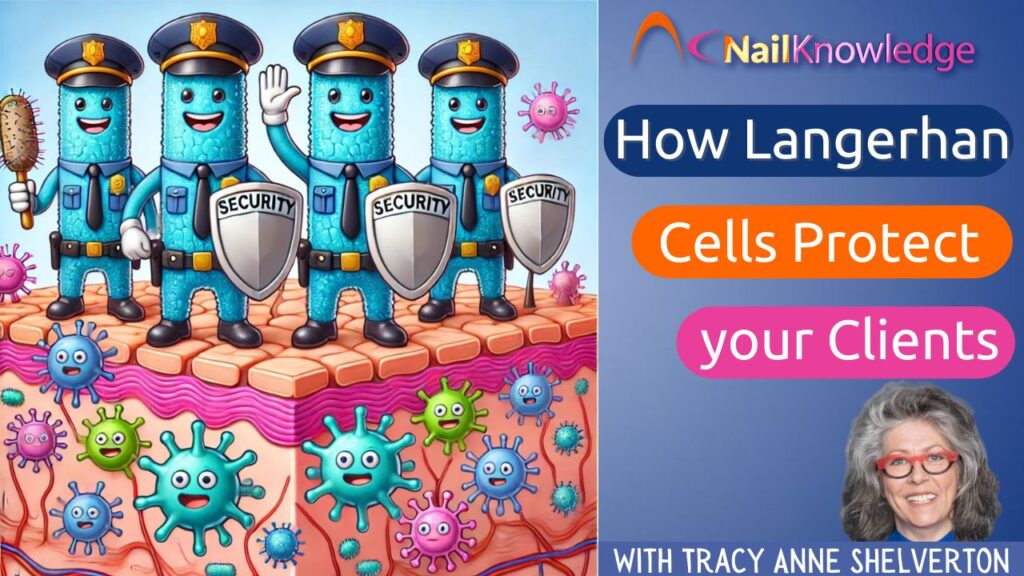As a nail technician, you’ve probably encountered situations where products like polish or acrylics accidentally leak onto the skin around the nail. While this might seem like a small mishap, there’s a lot more happening beneath the surface of the skin than meets the eye. In fact, your bodies have their own natural defenders working hard to protect us from harm, meet the Langerhans cells, the unsung heroes of the immune system.
What Are Langerhans Cells?
Langerhans cells are like the security guards of the skin, always on patrol and ready to defend against anything that shouldn’t be there. Found in the outermost layer of the skin (the epidermis), including the delicate area around the nails, these cells are essential to keeping our skin healthy.
So, what exactly do these tiny guardians do? Their main job is to detect harmful substances like bacteria, viruses, or even chemical irritants that may have entered the skin. Once they spot a threat, they capture it and alert the rest of the immune system to respond. Think of them as the first line of defense, always ready to call for backup when needed.
Why Nail Technicians Should Care
As a nail technician, understanding the role of Langerhans cells can help you better care for yourself and your clients. When a product leaks onto the skin, or a nail plate has been so thinned out by filing it can reach the nail bed where these cells are stationed. If the Langerhans cells detect something harmful, they spring into action. This might result in redness, swelling, that could eventually trigger an allergic reaction as the immune system works to protect the skin and no one wants that so its smart to pay attention and avoid that.
For example, let’s say a bit of gel polish accidentally seeps onto the skin, gets under the nail or even leaks into the nail bed. The Langerhans cells might recognize some of the chemicals in the polish as foreign or irritating. In response, they activate, leading to an inflammatory reaction. While this is a natural and protective response, it’s not pleasant, as it can cause discomfort and spoil the beautiful work you’ve just done.
Practical Tips for Nail Technicians
To minimize the chances of product leakage and the resulting immune response, here are a few practical tips:
- Use Precise Application Techniques: Be mindful of the amount of product you’re using, especially near the proximal nail fold and sidewalls of the nails. Consider using a smaller brush for detailed work to avoid accidental spills.
- Protect the Skin: Apply a barrier cream around the nails before starting your service. This can help prevent products from seeping into the skin.
- Clean Up Immediately: If any product does get on the skin, wipe it away as quickly as possible. The less time it has to sit on the skin, the lower the risk of triggering an immune response.
- Be Aware of Client Sensitivities: Some clients may have more sensitive skin than others. Knowing this can help you choose gentler products or adjust your application technique to avoid any issues.
- Stop thinning the nail plate: Removing the protection layers of the nail plate not only upsets the balance of the nail enhancement that you are creating but also opens the nail for invading pathogens or product leakage
Communicating with Clients
If a client does experience redness or irritation, it’s important to communicate with them clearly and calmly. Here’s a simple way to explain what’s happening:
“Your skin has these amazing cells called Langerhans cells that act like security guards. When something they don’t like, like a little bit of product gets on your skin, they might react by causing some redness or swelling. It’s just your body’s way of protecting you.”
By explaining the situation in this way, you can reassure your client that what they’re experiencing is a normal reaction and that you’re aware of how to handle it.
Understanding Langerhans Cells: Key to Healthy Skin and Safe Nail Care
Langerhans cells may be tiny, but their role in protecting your clients’ skin is huge. By understanding how these cells work, you can take steps to prevent product leakage and ensure that your clients leave your salon with not only beautiful nails but also healthy skin.
Next time you’re working on a client, remember these guardians of the nail, and use your knowledge to provide the best care possible. Your clients will thank you for it!


